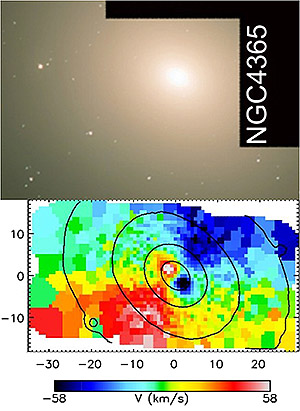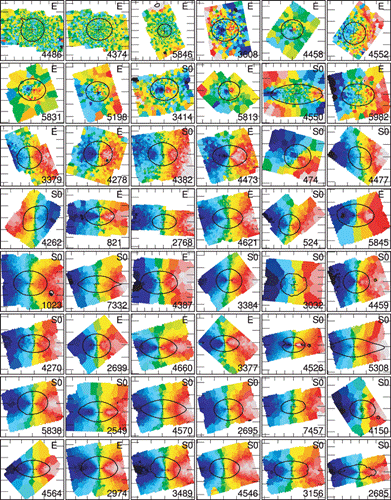On Friday 11 January 2013 the Royal Astronomical Society (UK) awarded the 2013 RAS ‘A’
Group award to the SAURON team. The prize, which honours groups that have made an outstanding
contribution to astronomy, will be presented at the 2013 National Astronomy Meeting (NAM 2013) to
be held in St Andrews, Scotland, in July. SAURON is an integral field spectrograph with a 33 x 44
arcseconds field of view (roughly 1/110th x 1/80th degree) at the 4.2m William Herschel Telescope. SAURON
saw first light in 1999. Although it can be used for other astrophysical investigations, the particular
science focus of the team that set up the SAURON project was understanding the evolution of elliptical
galaxies, via detailed observations of samples of nearby examples of these objects.
The SAURON initiative combines an impressive and optimised instrument design with the careful use
of models and simulations to interpret the results and a high degree of organization across the
collaboration. Whereas many previous projects of this type have foundered under the sheer volume of
the data and the complexity of the analysis task, the SAURON team has shown impressive efficiency in
publishing world-leading science results in a timely manner.
The project started with a survey of 72 galaxies (48 early-type and 24 spirals). It was followed by a
larger, complete survey, named ATLAS3D, covering 260 galaxies. To date, the SAURON team has
published over 60 papers that have attracted more than 3500 citations; 8 of the SAURON-based papers have
more than 100 citations each.
One of the most important, and surprising, results of the SAURON survey is that elliptical galaxies show
a lot of structure in their internal velocity fields. For example, in NGC 4365, a large elliptical galaxy in
the Virgo cluster, it was shown that the inner regions of the galaxy rotate perpendicular to the stars
further out.
 |
Figure 1. An example of a galaxy with a counter-rotating core. The upper panel shows an image of the
Virgo elliptical NGC 4365 taken with the Hubble Space Telescope. Below is shown the SAURON
stellar velocity field (for details see the caption of Figure 2). (Extracted from Davies et al., 2001, ApJ,
548, L33).
[ JPEG ]. |
Looking at the whole sample, it was shown that the two-dimensional stellar kinematics of early-type galaxies
come in two broad flavours, depending on whether they exhibit clear large-scale rotation or not.
 |
Figure 2. Example of SAURON project analysis: stellar velocity fields for 48 elliptical (E) and lenticular
(S0) galaxies, the global outer photometric axis being horizontal. Colour cuts are tuned for each
individual galaxy, in order to emphasize the observed velocity structures. A representative isophote
is overplotted in each thumbnail as a black solid line, and the centre is marked with a cross. The galaxies in
the first two rows are slow rotators. NGC numbers and Hubble types are given in the lowerright
and upper-right corners of each panel, respectively. Tick marks correspond to 10 arcsec.
(Extracted from Emsellem et al., 2007, MNRAS, 379, 401).
[ GIF ]. |
Other science highlights include the finding that the warm gas in a substantial fraction of elliptical
galaxies must have an external origin; a clear demonstration that young stellar populations are more
prevalent in lower mass galaxies, direct proof that some bulges of spiral galaxies are rotating fast, and
a fundamental revision of the galaxy classification scheme, based on a comparison between the
movement of stars in galaxies and their shapes.
SAURON has been a private instrument at the WHT for 13 years, and is still in use by scientists from
the UK, the Netherlands and Spain. It is open to the whole
community on a collaborative basis.
More information:
- The SAURON website, including the full list papers, published data, team members, and details
of observations at other wavelengths: http://www.strw.leidenuniv.nl/sauron.
- The ATLAS3D website, including the full list of papers of the ATLAS3D survey, published data,
and details of observations at other wavelengths: http://purl.org/atlas3d.
-
"Winners of the 2013 awards, medals and prizes - full details", RAS press release PR 13/2, 10th January 2013.



